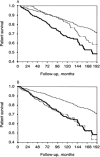Post-Transplant Diabetes Mellitus: Causes, Treatment, and Impact on Outcomes
- PMID: 26650437
- PMCID: PMC4740345
- DOI: 10.1210/er.2015-1084
Post-Transplant Diabetes Mellitus: Causes, Treatment, and Impact on Outcomes
Abstract
Post-transplant diabetes mellitus (PTDM) is a frequent consequence of solid organ transplantation. PTDM has been associated with greater mortality and increased infections in different transplant groups using different diagnostic criteria. An international consensus panel recommended a consistent set of guidelines in 2003 based on American Diabetes Association glucose criteria but did not exclude the immediate post-transplant hospitalization when many patients receive large doses of corticosteroids. Greater glucose monitoring during all hospitalizations has revealed significant glucose intolerance in the majority of recipients immediately after transplant. As a result, the international consensus panel reviewed its earlier guidelines and recommended delaying screening and diagnosis of PTDM until the recipient is on stable doses of immunosuppression after discharge from initial transplant hospitalization. The group cautioned that whereas hemoglobin A1C has been adopted as a diagnostic criterion by many, it is not reliable as the sole diabetes screening method during the first year after transplant. Risk factors for PTDM include many of the immunosuppressant medications themselves as well as those for type 2 diabetes. The provider managing diabetes and associated dyslipidemia and hypertension after transplant must be careful of the greater risk for drug-drug interactions and infections with immunosuppressant medications. Treatment goals and therapies must consider the greater risk for fluctuating and reduced kidney function, which can cause hypoglycemia. Research is actively focused on strategies to prevent PTDM, but until strategies are found, it is imperative that immunosuppression regimens are chosen based on their evidence to prolong graft survival, not to avoid PTDM.
Figures



 , inhibition is denoted by
, inhibition is denoted by  , and tentative inhibition by
, and tentative inhibition by  .
.
References
-
- Cosio FG, Hickson LJ, Griffin MD, Stegall MD, Kudva Y. Patient survival and cardiovascular risk after kidney transplantation: the challenge of diabetes. Am J Transplant. 2008;8:593–599. - PubMed
-
- Davidson J, Wilkinson A, Dantal J, et al. New-onset diabetes after transplantation: 2003 International Consensus Guidelines. Proceedings of an international expert panel meeting. Barcelona, Spain, 19 February 2003. Transplantation. 2003;75(10 suppl):SS3–SS24. - PubMed
-
- American Diabetes Association. 2 Classification and diagnosis of diabetes. Diabetes Care. 2015;38(suppl 1):S8–S16. - PubMed
-
- World Health Organization. Definition and diagnosis of diabetes mellitus and intermediate hyperglycaemia. Report of a WHO/IDF Consultation. Geneva, Switzerland: WHO; 2006.
Publication types
MeSH terms
Substances
LinkOut - more resources
Full Text Sources
Other Literature Sources
Medical
Research Materials

